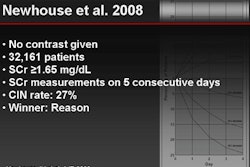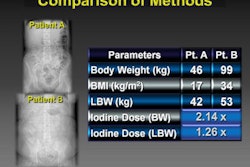A little geography goes a long way in computer-aided detection (CAD) of virtual colonoscopy. Researchers from the National Institutes of Health (NIH) in Bethesda, MD, and Old Dominion University in Norfolk, VA, have found a novel way to use topographical height mapping for polyp detection and measurement.
In a large patient database, their process generated unusually high sensitivity for polyp detection, with fewer than three false-positive detections per dataset.
Computer-aided detection of virtual colonoscopy (also known as CT colonography or CTC) data has grown increasingly sophisticated in recent years in detecting the shapes and features that represent colorectal lesions in CT datasets. A few systems are available commercially; however, none of the current CAD methods makes use of the very knowledge radiologists use to detect polyps, according to the authors.
Because human eyes searching for polyps in 3D endoluminal images can find lesions with high sensitivity, the authors began to consider ways in which CAD might also distinguish polyps from normal mucosa in 3D datasets. Protrusions from the mucosa were the obvious choice.
"Inspired by the way radiologists detect polyps via 3D virtual fly-through in CTC, we borrowed the idea from geographic information systems to employ topographical height map in colonic polyp measurement and false-positive reduction," wrote Jianhua Yao, Ph.D., Jiang Li, Ph.D., and Dr. Ronald Summers, Ph.D. (Pattern Recognition, June 2009, Vol. 42:6, pp. 1029-1040).
An earlier study by Li et al proposed a method based on 2D endoluminal projection images, the authors noted. Li and colleagues "computed the projection images using graphical snapshot through an optimized viewpoint and derived wavelet coefficients as texture features for classification," Yao et al wrote. "In this paper, we propose an approach based on topographic height map, which is potentially more robust."
Height maps, also known as digital elevation models, are commonly used in geographic information systems. They employ remote sensing techniques such as radar or light detection and ranging (LIDAR) to determine the distance from the sensor to an object or surface.
"A similar idea has also been applied in range imaging, where structure lights coupled with calibrated optical cameras are employed to reconstruct the depth features of a surface," they wrote. The distance or depth is then converted to elevation data, which can be used to identify structures such as mountains in a terrain.
The system
Following curvature-based filtering and the use of a 3D CT feature classifier on CTC datasets, the system computes a height map for each candidate polyp detection using a ray-casting algorithm, Yao and colleagues explained.
The features of the polyp candidates are then fed to a classifier, or support vector machine. A height map is generated for each detection passed through the classifier. The system optimizes the height map using a multiscale spiral spherical search to maximize the concentric index, the authors explained.
"We derive several topographic features from the map and compute texture features based on wavelet decomposition," they wrote. "We then send the features to a committee of support vector machines for classification to reduce the number of false-positive detections."
The system pipeline includes three classification stages: surface curvature filter, CT feature classifier, and height map feature classifier. The present study is focused on the height map stage, which is used in two main applications: the CAD system for polyp detection, and the measurement of polyp size.
Height map generation is based on a ray-casting technique, in which a projection plane is defined and placed over every CAD system detection, they wrote. The projection plane is determined by its normal, its distance to the colon surface, and the location of the detection.
Height map
The height map process uses orthogonal projection to avoid the projection distortion associated with perspective projection. For every point on the projection plane, a ray is cast onto the colon surface. Then an "implicit isosurface associated with the colon surface in the 3D image" is used to locate the point at which the projection plane encounters the colon surface, the authors wrote.
"Since the colon is a curved tubular structure and orthogonal projection is used, the height values for pixels off the center of the map are artificially higher than they actually are," Yao and his team wrote. "We need to flatten the colon to get precise height measurement. We virtually flatten the colon by compensating the height distance measurement according to the distance to the center of the map."
Polyp measurement
Polyp height and width are two critical polyp characteristics that are difficult to ascertain due to the difficult-to-discern boundaries between polyp and the normal colon. The authors' method uses the height map is used to solve this problem.
Polyp measurement requires the location of the tip and the base of the polyp, represented by the highest point in the center of the height map. A directional height profile is used to determine the intersection of the polyp neck and the surface of the normal mucosa. The polyp height is the average height difference between polyp tip and polyp neck points, and the polyp width is the average of span distances, they wrote.
Study details
The screening population in the study consisted of 1,186 adults between 40 and 79 years of age at three medical institutions (Pickhardt et al, NEJM, December 4, 2003, Vol. 349:23, pp. 2191-2200).
All of the screening subjects underwent a 24-hour cathartic preparation consisting of 90 mL sodium phosphate, 10 mg bisacodyl, 500 mL barium (2.1%), and 120 mL diatrizoate meglumine and diatrizoate sodium given in divided doses.
Patients were scanned prone and supine at CT, using 1.25- to 2.5-mm collimation and 1-mm reconstruction intervals. They also underwent optical colonoscopy on the same day following CTC. Detected polyps were manually segmented by a reader panel and used as a reference standard for CAD training and validation.
The evaluations were conducted for polyps 10 mm or larger and between 6 and 9 mm. The authors compared the results before and after the height map features were applied in the classification.
The training and test datasets were separate; the classifier was created using the test set and 10-fold validation and then independently validated on a separate test set, the team wrote. Polyp height and width were also measured manually on a workstation (V3D software, Viatronix, Stony Brook, NY).
There were 226 colonoscopy-confirmed polyps larger than 6 mm. For polyps 10 mm or larger, the false-positive rate was reduced from 2.65 to 1.42 at 96% sensitivity in the training set -- and from 4.9 to 1.2 at 93% sensitivity in the test set, the authors reported.
For 6- to 9-mm polyps, the false-positive rate was reduced from 5.14 to 2.33 at 77% sensitivity for polyps in the training set -- and from 6.86 to 3.1 at 76% sensitivity in the test set. Most false-positive detections eliminated by the height map classifier were fold structures and artifacts created by fluid interface, Yao and colleagues wrote.
Results showed that the method achieved 95% sensitivity at 2.4 false positives per patient. In addition, the height map feature reduced false positives by more than 50%, they wrote.
Polyp height and width measurements were correlated with manual measurements. The Pearson correlations are 0.74 (p = 0.11) and 0.75 (p = 0.17) for height and width, respectively.
"We proposed a novel technique to distinguish colonic polyps from normal colon surfaces based on topographical height maps," the authors wrote. "The novelty of this technique is that in addition to using the original 3D CT image, it uses height maps which reveal several visual properties that radiologists perceive to detect polyps."
The technique can reduce false-positive detections by more than half, and it works equally well for large polyps (≥ 10 mm) and medium-sized polyps (6-9 mm), the authors concluded.
Future work will incorporate more topographic features, such as profile curvatures, ridge lines, and the computation of incident radiation. A more precise concentric index will be investigated, and height map features will be used to evaluate polyp conspicuity.
By Eric Barnes
AuntMinnie.com staff writer
July 27, 2009
Related Reading
Hyperplastic polyps flatten out with VC insufflation, March 11, 2009
Teniae coli landmarks guide navigation in VC, January 2, 2008
VC CAD ramps up detection of medium-sized polyps, March 12, 2007
VC CAD delivers accuracy on unfamiliar datasets, February 5, 2007
Support vector machines boost accuracy of VC CAD, May 3, 2005
Copyright © 2009 AuntMinnie.com



















